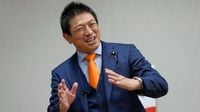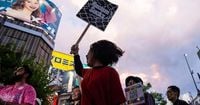On a humid evening near a bustling train station outside Tokyo, hundreds of supporters gathered in anticipation. Their cheers rose as Sohei Kamiya, leader of the nationalist Sanseito party, took the stage, his voice booming with conviction as he railed against Japan’s rapidly growing foreign population. According to Business Standard, the scene was emblematic of a new political energy sweeping Japan—a surge of anti-foreigner sentiment that is reshaping the nation’s political landscape amid an unprecedented population crisis.
Sanseito, still considered a minor party until recently, made substantial gains in the July 2025 parliamentary election. Kamiya’s “Japanese First” platform—firmly anti-globalist, anti-immigration, and anti-liberal—has found a receptive audience, especially as Japan prepares for a pivotal ruling party vote on October 4, 2025, which will determine the country’s next prime minister. As The Associated Press reported, all five candidates vying for leadership of the ruling Liberal Democratic Party have promised tougher measures on foreigners, reflecting a hardening stance that now permeates even mainstream politics.
It’s not hard to see why this message resonates. Many Japanese are grappling with dwindling salaries, rising prices, and a bleak outlook for the future. “Many Japanese are frustrated by these problems, though we are too reserved to speak out. Mr. Kamiya is spelling them all out for us,” said Kenzo Hagiya, a retiree who attended Kamiya’s rally and described the “foreigner problem” as one of his biggest concerns, according to AP.
Yet, this populist surge comes at a time when Japan’s demographic realities are impossible to ignore. The country, long known for its insular culture and emphasis on conformity, is facing a population crisis of historic proportions. In 2024, the foreign population hit a record high of over 3.7 million—about 3% of the national population—while the foreign workforce tripled over the past decade to 2.3 million, with an increase of 300,000 from the previous year, as reported by the Ministry of Health, Labor and Welfare. Many of these workers fill essential roles in manufacturing, retail, farming, and fishing.
Despite the surge, the numbers fall far short of what experts say is necessary. According to a 2022 study by the Japan International Cooperation Agency, the nation will need three times more foreign workers—6.7 million in total—by 2040 to achieve even modest economic growth of 1.24% annually. Without them, analysts warn that key sectors of the Japanese economy will become paralyzed.
But the political climate is anything but welcoming. In September 2025, angry protests—fueled by misinformation on social media about a supposed influx of African immigrants—forced the cancellation of a government-led exchange program between four Japanese municipalities and African nations. Even the ruling Liberal Democratic Party, which has historically promoted foreign labor and tourism, is now calling for tighter restrictions on foreigners. Yet, as AP notes, party leaders have not explained how Japan can survive economically without foreign workers.
Kamiya, for his part, insists his views are not about racism. “We only want to protect the peaceful lives and public safety of the Japanese,” he declared at a rally in Yokohama, a city with a large foreign population. He added, “Japanese people tolerate foreigners who respect the ‘Japanese way,’ but those who cling to their own customs are not accepted because they intimidate, cause stress and anger the Japanese.” Kamiya has repeatedly argued that the government’s policies benefit big Japanese businesses at the expense of ordinary citizens. “Why do foreigners come first when the Japanese are struggling to make ends meet and suffering from fear? We are just saying the obvious in an obvious way. Attacking us for racial discrimination is wrong,” he said, as quoted by Business Standard.
The anti-immigrant rhetoric has gained traction not just among the far right. During the July election campaign, far-right candidates targeted Japan’s small Kurdish community—about 2,000 people, many of whom fled persecution in Turkey. One Kurdish citizen, who escaped to Japan as a child after his father was arrested for complaining about military hazing, described being called a criminal on social media. The discrimination is not new: Japan has a long history of prejudice against ethnic Koreans and Chinese, dating back to its colonial era in the early 20th century. Insults and attacks against Chinese immigrants and investors persist today.
For many foreigners, daily life in Japan can be a struggle. Hoang Vinh Tien, a 44-year-old Vietnamese resident who has lived in Japan for more than two decades, says that foreigners are often underpaid and face discrimination, including in renting apartments. Still, he said, “As we hear about trouble involving foreigners, I share the concerns of the Japanese people who want to protect Japan, and I support stricter measures for anyone from any country, including Vietnam,” as reported by AP.
Yet, the statistical reality tells a different story from the alarmist rhetoric. Despite the surge in the foreign population, only about 12,000 foreigners were arrested in 2024, according to the National Police Agency—hardly evidence of a crimewave, despite claims to the contrary.
The roots of the current backlash are complex. Many Japanese view immigrants as cheap labor who speak little Japanese, allow their children to drop out of school, and live in high-crime communities, said Toshihiro Menju, a professor at Kansai University of International Studies and an expert on immigration. He argues that much of the prejudice comes from Japan’s “stealth immigration system,” which accepts foreign labor as de facto immigrants but fails to provide adequate support or public explanation to foster acceptance.
Sanseito’s rise reflects a broader dissatisfaction with the political status quo. Founded in 2020, the party began as a social media movement led by Kamiya, a former assembly member from Suita near Osaka. He attracted followers with revisionist takes on Japanese history, conspiracy theories, anti-vaccine rhetoric, and spiritualism. Kamiya has openly stated he is “extremely inspired by the anti-globalism policies” of U.S. President Donald Trump, although he claims to reject Trump’s style. He has also drawn parallels between Sanseito and far-right parties in Europe, such as Germany’s AfD and France’s National Rally.
Looking ahead, Kamiya’s ambitions are clear. He told AP that his priority is to expand Sanseito’s support base and field more than 100 candidates in future elections. Meanwhile, the party’s influence continues to grow, even as some supporters admit they have never personally encountered trouble with foreigners.
Japan’s population crisis is not going away, and the nation’s future may depend on its ability to reconcile economic necessity with a changing political mood. Whether the country can strike that balance remains to be seen, but for now, the debate over foreign workers and national identity is front and center—and only intensifying as new leaders prepare to take the helm.


